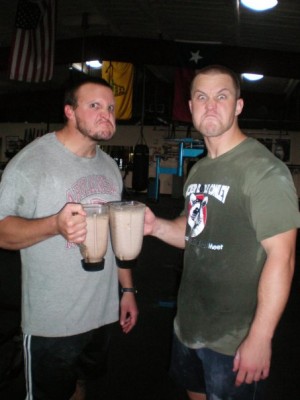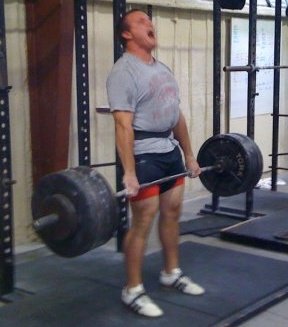“When one teaches, two learn.”
–Robert Heinlein
Some of you may be familiar with barbell training as it has been taught by Mark Rippetoe, whether learning it by attending the Basic Barbell seminar through CrossFit, reading his books, Starting Strength: Basic Barbell Training and Practical Programming for Strength Training, that are published by The Aasgaard Company, or viewing the media that has been available through CrossFit.com over the past few years.
In order to ensure the quality and effectiveness of the coaches, the Basic Barbell seminar has been expanded into the Starting Strength Seminar. This new seminar is longer and more detailed with a 3-day format that allows the attendee to gain a better, more thorough understanding of the biomechanical model of the exercises that operate in a gravitational framework, how to appropriately coach the basic barbell exercises, how to program these exercises into an effective strength and conditioning program, as well as learning and performing the exercises.
The SSS is an incredibly valuable learning experience that cannot be attained anywhere else in the fitness industry. The value is augmented by the new testing format that will include an evaluation on the ability to coach and perform the exercises as well as an online exam that can be taken after the seminar. Passing both the practical and written assessments will award the attendee with a Starting Strength Coach certificate as well as access to an online “coaches only” message board, being included in an online directory of barbell coaches to refer trainees to you, as well as instant access to the experienced staff of the SSS. Many will learn extensively from attending the seminar, but only the best will earn the certificate.
If you have ever been interested in coaching barbell training, this is a good place to start. The more coaches we have with their heads on straight, the better the strength and conditioning field will become. More information on the seminars can be found at here. If you have any questions, concerns, or comments, feel free to e-mail me any time.
———-

Hi Chris
By now you have read about my training partner (and super friend), Chris. We did a bit of filming last Friday, and the video below consists of his training session. Chris’ “story” is important for a few reasons.
1. Shoulder Injury
In January Chris had pretty serious shoulder injury — we think he had some kind of tear in his supraspinatus. He could barely lift a 15 pound bar overhead. I started working with him, getting him to press that bar for more and more reps every day. Eventually he could do 3 sets of 25. Chris slowly increased the weight while titrating the reps down until he was able to do 3 sets of 5 for sets across. We did the same thing on the bench press, and eventually he worked up to being on a linear progression in both presses. At the end of his linear progression, he benched 317x5x3 and pressed 210x5x3. Not bad considering he started at zero.

Riley v. Lascek
2. Bigger Guy on the Linear Progression
When Chris started all of this, he was a pretty big guy at 6’ and 250 lbs. We talked multiple times about his diet early on, and it was made clear that he should eat plenty of eggs, meat, and milk and take it easy on the carbs. Larger guys don’t need extraneous calories, they need protein, and calories to fuel their training. Gant always says eat enough protein to maintain or increase your muscle mass, enough carbs to fuel your workout, and enough fat to recover. With strength training, you don’t need a whole lot of carbs if you aren’t trying to gain a lot of weight. Chris loves to grill, so he eats a LOT of meat and eggs. “They are the BAYST”, he says.

Chris and I drinking 70’s Big shakes when we were skinnier
About 2 months ago, Chris and I were training and he was at the water fountain. When he walked by, his back looked massive. I said, “Dude, you’re lookin’ kinda big, how much do you weigh?”
“250, I think.”
“Well, go weigh yourself.”
He was 265 and didn’t even know it. 15 pounds of muscle in a few months time. I assure you, his girlfriend wasn’t complaining. (Fun fact: Chris’ girlfriend and sister were some of the original gals to be supportive of our 70’s Big idea early on.)
3. Groin Injury
During the linear progression, Chris got up to squatting around 450 for his work sets, but strained something in his lateral groin area (I think it was the sartorius). This kept him from squatting with a bar for at least a month and a half. The injury got a little better, so I had him start squatting with an empty bar while in pain. We went through the injury protocol, working up the weight, titrating the reps down. He got back up into the upper 300’s for his work sets, but he still felt some residual pain. So, instead, we moved his squat to the Texas Method. This injury was not due to a form problem, and so we experimented with the Texas Method (5×5 volume on Monday, light day on Wednesday, and 3RM intensity on Friday) to see if it would heal up with less weekly volume. It did; as you can see in the video, he squats 500 for a very easy triple.

Chris pulling 625
4. Natural Deadlifter
When I started working with Chris on the linear progression, he pulled 445 for an easy set of five. From there, he made quick work of the deadlift (his favorite lift) by making 15 pound jumps up until 500. From there he made 10 pound jumps, then a few five pound jumps to finish with 545 for a set of 5 (the most he had ever pulled). A few weeks later he pulled 600 and 625 (with a slight hitch on the latter). Chris loves him some deadlift.
